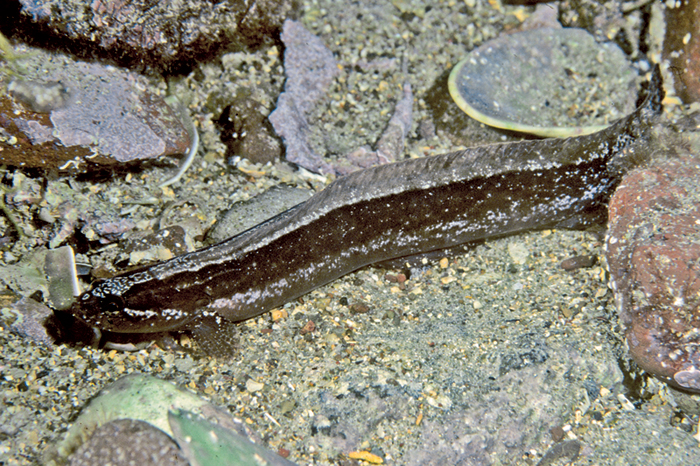Frosted Snake Blenny, Ophiclinus gabrieli Waite 1906
Other Names: Black-back Snake-blenny, Frosted Snakeblenny, Frosted Snake-blenny, Gabriel's Snake Blenny

A Frosted Snake Blenny, Ophiclinus gabrieli, in Port Phillip, Victoria. Source: Rudie H. Kuiter / Aquatic Photographics. License: All rights reserved
Summary:
A dark brown snake blenny with distinct white mottling in a grey stripe running from the snout to the top of the head and along the dorsal-fin base, forming white blotches posteriorly, a diffuse white stripe from the rear of each eye running along the midside and forming a series of large white blotches posteriorly, a series of white blotches along the rear sides just above the anal-fin base, and dark lines radiating from the eyes, especially posteriorly. The dorsal fin is grey, and the caudal and anal fins are brown, each with white speckles, especially towards the rear of the fin.
Cite this page as:
Bray, D.J. 2022, Ophiclinus gabrieli in Fishes of Australia, accessed 27 Jun 2025, https://fishesofaustralia.net.au/home/species/1105
Frosted Snake Blenny, Ophiclinus gabrieli Waite 1906
More Info
|
Distribution |
Endemic to the south coast of Australia from Wilsons Promontory, Victoria, and northern Tasmania, to Kangaroo Island and Spencer Gulf, South Australia. Inhabits shallow macroalgal and seagrass areas, near rocky outcrops, in tidal rock pools, and sandy areas with sparse seagrass and algal cover. |
|
Features |
Dorsal fin LII-LV, 1; Anal fin II, 33-36; Caudal fin 13-15; Pectoral fin 11-12; Pelvic fin I, 2. Body shallow (11-14% SL). Head small (18-21% SL); eyes small (15-22% HL); tube of anterior nostrils without fleshy flap at tip; mouth small (upper jaw length 33-37% HL), nearly horizontal, maxillae reaching slightly beyond hind edge of eyes; roof of mouth with V or U-shaped row of teeth. Lateral line consisting of 12-16 pores originating above opercles, followed by series of pit-like depressions; front pore in series of pores running down and forward on each cheek paired. Dorsal fin arising above rear of opercles, membranes between anal fin rays not distinctly notched at edge; caudal fin rounded. Pectoral fins of moderate size, much longer than eye diameter. Pelvic fins much longer than eye diameter, arising slightly in front of and below pectoral fin bases. |
|
Size |
The Frosted Snake Blenny is the largest species of Ophiclinus, and reaches a total length of 17.5 cm. |
|
Colour |
Dark brown with distinct white mottling in grey stripe on top of snout and head, and along base of dorsal fin, forming white blotches posteriorly; diffuse white stripe from rear of each eye along centre of sides, forming a series of large white blotches posteriorly; series of white blotches posteriorly on sides just above base of anal fin; dark lines radiating from eyes, especially posteriorly; dorsal fin grey, caudal and anal brown, each with white speckles, especially concentrated posteriorly. |
|
Etymology |
The species is named in honour Charles John Gabriel, who collected type specimen while dredging for molluscs. |
|
Species Citation |
Ophioclinus gabrieli Waite 1906, Rec. Aust. Mus. 6(3): 208, pl. 36, fig. 7. Type locality: Western Port, Victoria (lectotype). |
|
Author |
Bray, D.J. 2022 |
|
Resources |
Frosted Snake Blenny, Ophiclinus gabrieli Waite 1906
References
Edgar, G.J. 2008. Australian Marine Life: the plants and animals of temperate waters. Sydney : Reed New Holland 2nd edn, 624 pp.
George, A. & Springer, V.G. 1980. Revision of the clinid fish tribe Ophiclinini, including five new species, and definition of the family Clinidae. Smithsonian Contributions to Zoology 307: 1-31 figs 1-14 https://doi.org/10.5479/si.00810282.307
Hoese, D.F., Gomon, M.F. & Rennis, D.S. 2008. Family Clinidae. pp. 696-722 in Gomon, M.F., Bray, D.J. & Kuiter, R.H. (eds) Fishes of Australia's Southern Coast. Sydney : Reed New Holland 928 pp.
Kuiter, R.H. 1993. Coastal Fishes of South-eastern Australia. Bathurst : Crawford House Press 437 pp.
Kuiter, R.H. & Kuiter, S.L. 2018. Fish watchers guide to coastal sea-fishes of south-eastern Australia. Seaford, Victoria : Aquatic Photographics 371 pp.
Last, P.R., Scott, E.O.G. & Talbot, F.H. 1983. Fishes of Tasmania. Hobart : Tasmanian Fisheries Development Authority 563 pp. figs.
Rennis, D., Hoese, D.F. & Gomon, M.F. 1994. Family Clinidae. pp. 741-775, figs 650-684B in Gomon, M.F., Glover, C.J.M. & Kuiter, R.H. (eds) The Fishes of Australia's South Coast. Adelaide : State Printer 992 pp. 810 figs.
Waite, E.R. 1906. Descriptions of and notes on some South Australian and Tasmanian fishes. Records of the Australian Museum 6(3): 194-210 figs 34-36. See ref. at BHL
Williams, J.T., Holleman, W. & Clements, K.D. 2014. Ophiclinus gabrieli. The IUCN Red List of Threatened Species 2014: e.T179100A1569588. http://dx.doi.org/10.2305/IUCN.UK.2014-3.RLTS.T179100A1569588.en. Downloaded on 25 March 2017.







